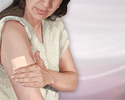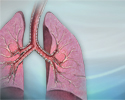Smoking and COPD
Chronic obstructive pulmonary disease - smoking; COPD - secondhand smoke
Smoking is the leading cause of chronic obstructive pulmonary disease (COPD). Smoking is also a trigger for COPD flare-ups. Smoking damages the air sacs, airways, and the lining of your lungs. Injured lungs have trouble moving enough air in and out, so it may be hard to breathe.
Information
Things that make COPD symptoms worse are called triggers. Knowing what your triggers are and how to avoid them can help you feel better. Smoking is a trigger for many people who have COPD. Smoking can cause an exacerbation, or flare-up, of your symptoms.
You do not have to be a smoker for smoking to cause harm. Exposure to someone else's smoking (called secondhand smoke) is also a trigger for COPD flare-ups.
Smoking damages your lungs. When you have COPD and you smoke, your lungs will get damaged more rapidly than if you were to stop smoking.
Quit Smoking
Quitting smoking is the best thing you can do to protect your lungs and keep your COPD symptoms from getting worse. This can help you stay more active and enjoy life.
Tell your friends and family about your goal to quit. Take a break from people and situations that make you want to smoke. Keep busy with other things. Take it 1 day at a time.
Ask your health care provider to help you quit. There are many ways to quit smoking, including:
- Medicines
- Nicotine replacement therapy
- Support groups, counseling, or stop-smoking classes in person or online
It is not easy, but anyone can quit. Newer medicines and programs can be very helpful.
List the reasons you want to quit. Then set a quit date. You may need to try quitting more than once. And that's OK. Keep trying if you do not succeed at first. The more times you try to quit, the more likely you are to be successful.
Avoid Secondhand Smoke
Secondhand smoke may trigger COPD flare-ups and cause more damage to your lungs. So you need to take steps to avoid secondhand smoke.
- Make your home and car smoke-free zones. Tell others you are with to follow this rule. Take ashtrays out of your home.
- Choose smoke-free restaurants, bars, and workplaces (if possible).
- Avoid public places that allow smoking.
Setting these rules can:
- Reduce the amount of secondhand smoke you and your family breathe in
- Help you quit smoking and stay smoke-free
If there are smokers at your workplace, ask someone about policies regarding if and where smoking is allowed. Tips to help with secondhand smoke at work are:
- Make sure there are proper containers for smokers to throw away their cigarette butts and matches.
- Ask coworkers who smoke to keep their coats away from work areas.
- Use a fan and keep windows open, if possible.
- Use an alternative exit to avoid smokers outside the building.
References
Criner GJ, Bourbeau J, Diekemper RL, et al. Prevention of acute exacerbations of COPD: American College of Chest Physicians and Canadian Thoracic Society guideline. Chest. 2015;147(4):894-942. PMID: 25321320 pubmed.ncbi.nlm.nih.gov/25321320/.
Global Initiative for Chronic Obstructive Lung Disease (GOLD) website. Global strategy for the diagnosis, management, and prevention of chronic obstructive pulmonary disease: 2023 report. goldcopd.org/2023-gold-report-2/. Accessed October 26, 2023.
Han MK, Lazarus SC. COPD: clinical diagnosis and management. In: Broaddus VC, King TE, Ernst JD, et al, eds. Murray and Nadel's Textbook of Respiratory Medicine. 7th ed. Philadelphia, PA: Elsevier; 2022:chap 64.
Rochester CL, Nici L. Pulmonary rehabilitation. In: Broaddus VC, King TE, Ernst JD, et al, eds. Murray and Nadel's Textbook of Respiratory Medicine. 7th ed. Philadelphia, PA: Elsevier; 2022:chap 139.
Smoking tips to quit
Animation
Chronic obstructive pulmonary disease
Animation
Smoking and COPD (chronic obstructive pulmonary disorder) - illustration
Smoking and COPD (chronic obstructive pulmonary disorder)
illustration
Review Date: 10/13/2023
Reviewed By: Linda J. Vorvick, MD, Clinical Professor, Department of Family Medicine, UW Medicine, School of Medicine, University of Washington, Seattle, WA. Also reviewed by David C. Dugdale, MD, Medical Director, Brenda Conaway, Editorial Director, and the A.D.A.M. Editorial team.







